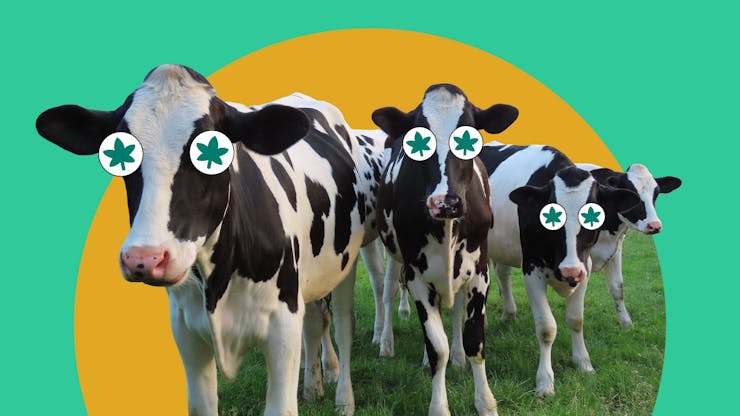Scientists at Kansas State University have found that feeding hemp to cows helps them sit the hell down and chill the eff out.
In an absolutely serious study published this week in Scientific Reports (a publication of the prestigious journal Nature) K-State veterinary researchers Hans Coetzee and Michael Kleinhenz discovered that a diet of industrial hemp “increases lying behavior and decreases biomarkers of stress and inflammation in cattle.”
If you feed hemp to a cow, it’ll lie down and chill. Science!
In other words, eating hemp makes cows mellow.
Hemp, of course, is cannabis that contains less than 0.3% THC. Although it’s low in THC by definition, hemp contains a host of other cannabinoids—including CBD and CBG—than can have psychoactive, but not intoxicating, effects in humans.
Until now, it’s been unclear exactly what effect cannabis above or below the 0.3% THC level would have on domesticated ruminants.
“Although hemp can be legally cultivated under license in Kansas, feeding hemp products to livestock remains prohibited because the potential for cannabinoid drug residues to accumulate in meat and milk has not been studied,” said study co-author Hans Coetzee, professor and head of the anatomy and physiology department in Kansas State’s College of Veterinary Medicine. Coetzee was interviewed by Joe Montgomery in K-State News.

Cannabinoid-free milk…or cannabinoid-enriched milk?
The Kansas State team recently received a $200,000 grant from the U.S. Department of Agriculture to establish concentrations of cannabinoids in livestock after exposure to industrial hemp. If scientists can show that cows fed a diet that includes hemp do not pass along cannabinoids in their milk or meat, hemp could become a viable feedstock in global markets.
If cows do pass along cannabinoids in their milk, though…speaking for a 420-friendly audience, that could create its own specialized niche market as well. Although the chances of the FDA allowing the sale of cannabinoid-enriched milk would be, admittedly, slim at best.
Secondary use for hemp leaves
“Industrial hemp is typically grown to produce oil, seed, fiber and medicines,” said study co-author Michael Kleinhenz, assistant professor of beef production medicine. “While varieties of hemp may be planted for a single or dual purpose, such as for seed and fiber, byproducts consisting of leaves, fodder and residual plant fibers remain after harvest. These byproducts could serve as potential feedstuffs for animals. Because these are predominantly cellulose-containing plant materials, the ideal species for utilizing these feeds are ruminant animals, specifically cattle.”
Earlier study on cannabinoids in plasma
In an earlier study published in 2020, the Kansas State team found detectable levels of the cannabinoids CBDA, THCA, CBCA, and CBVA in the plasma of cows that were fed a diet of industrial hemp.
That study did not test the milk of cows for cannabinoid levels. The detected levels of cannabinoids did not necessarily eliminate the use of hemp as a feedstock, as much more research needs to be done on the degradation and elimination of cannabinoids.
“This work is an important first step towards follow-up studies that are needed to characterize cannabinoid absorption, distribution, metabolism, and excretion in cattle,” the scientists wrote. “Specifically, additional work is required to determine edible tissue residue profiles for cannabinoids in cattle.”
In other words: Many more cows need to eat a lot more hemp before we can draw stronger conclusions.







